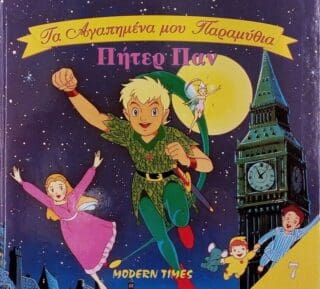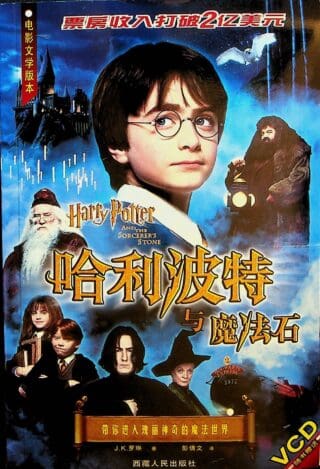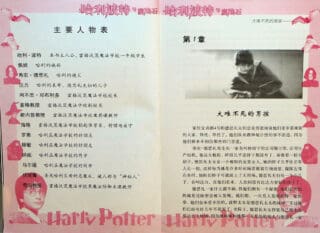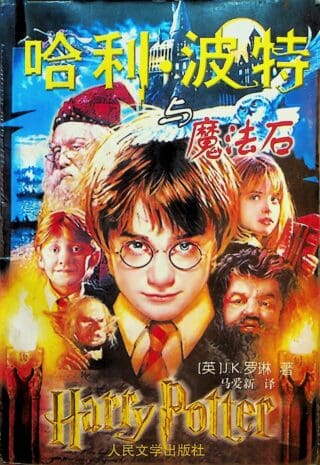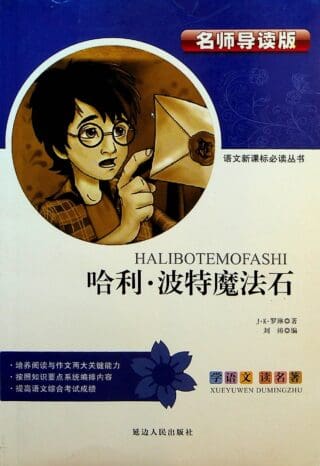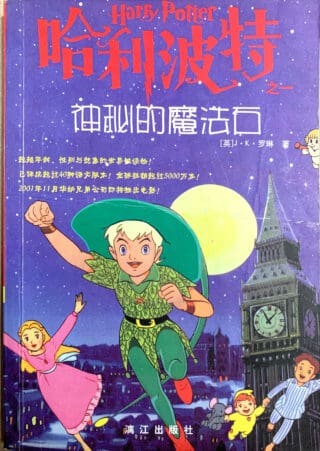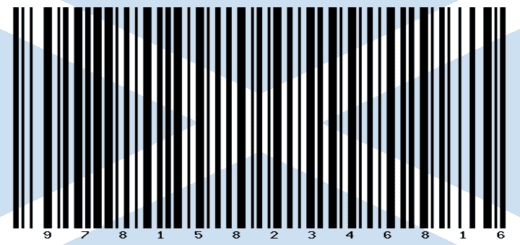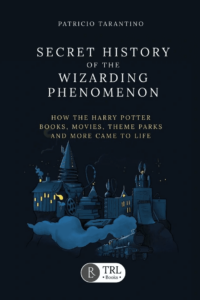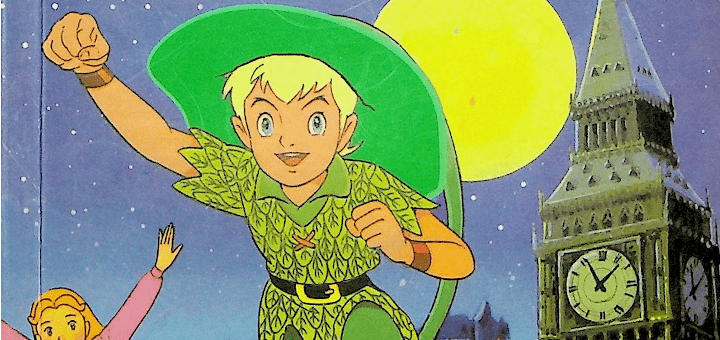 Harry Potter and the Bewildering Chinese Abominations
Harry Potter and the Bewildering Chinese Abominations
A basic understanding of the two Chinese writing systems (Traditional and Simplified) and how they are related is useful for this article. If you need an introduction or a refresher take a look at this article first: A Quick and Dirty Introduction to Traditional and Simplified Chinese Transliteration
You know when you get a tight knot in string or yarn or shoelaces or whatever? And you don’t want to just cut it or throw it away so you spend a ridiculous amount of time picking away at the knot, slowly loosening it up until it finally eases up enough for you to pull it apart entirely?
That’s how I feel about unauthorized Chinese books (by which for the purposes of this article, I mean Simplified Chinese books published in PRC). What the heck is going on in China‽ Bootlegs and parodies and fakes (oh my!)—so many different books and so many that are deliberately trying to obscure their origins! I’ve already touched on some of the complexities when I announced a new unauthorized translation and then subsequently retracted it—it turned out to be an abridged bootleg of the official Simplified Chinese translation by Su Nong that was attributed to a made-up name. But also when I wrote about how “Su Nong” is, itself, a blend of the names of two different translators.
Ordinarily I don’t pay this much attention to these types of unauthorized books—my interest is always focused on unauthorized translations or other ‘linguistically interesting’ variations. However, in the case of Chinese, they aren’t easy to classify upfront—you need to investigate each one pretty thoroughly just to categorize it. So, I have been expending some effort trying to sort them out.
First there’s the relatively simple task of discarding all the “fake translations”—Oh yeah, that’s right. “Fake translations” are a thing: Harry Potter books that are attributed to J.K. Rowling and were supposedly ‘translated’, but aren’t real Harry Potter books. Here are a couple of choice examples:
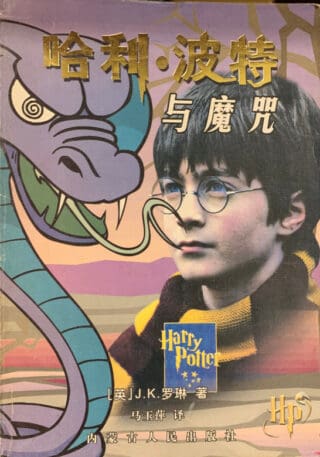
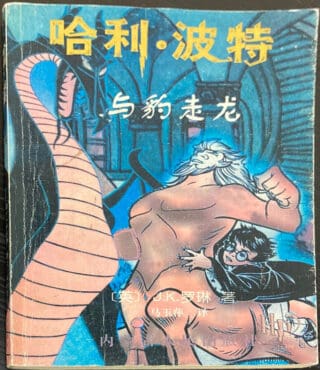
The one on the left is titled 哈利·波特与魔咒 which is something like “Harry Potter and the Magic Spell”; it says the author is J.K. Rowling and the translator is Yuping Ma (马玉萍), another alias. However, the copyright page provides a translation of the title: “Harry Potter and Beaker and Burn” (spelled a variety of ways—the fakes aren’t known for their quality). It even gives credit to Mary GrandPr’e (sic) for the cover art.
2023-03-09 Addition: ZChen made the obvious-in-hindsight observation that “Beaker and Burn” is a very poor back-translation of the Chinese “Goblet of Fire” back into English!
On the right is 哈利·波特与豹走龙 also attributed to J.K. and Yuping Ma. Both are supposedly published by Inner Mongolia People’s Publishing House (内蒙古人民出版社) which is a real publisher that immediately denied having anything to do with it. The title is challenging to understand; it literally means “Harry Potter and Leopard Walks Dragon”. The English translation of the title published with the book itself, right on the back cover doesn’t help much: “Harry Potter and Leopard Walk Up To Dragon”. What? According to wikipedia, 豹走龙 is actually one of the character names in the book. At least if that’s the case, we can make grammatical sense out of the title (“Harry Potter and Bao Zoulong”), even if it is still incomprehensible. Reportedly, the bulk of the book was lifted from “The Hobbit”—in the first chapter, magic rain turns Harry into a hobbit and in the last chapter he gets transformed back. Seriously, you can’t make this stuff up! This book actually created a bit of stir and was noticed by the English media when it came out in the period between Goblet of Fire and Order of the Phoenix.
2023-03-09 Addition: ZChen had some insights into this bizarre title! They think that 豹走龙, “Bao Zoulong” is actually word play. The character 豹 is pronounced the same as the character 暴 and 暴走 figuratively means “to go berserk”. In which case the name would translate to something like “rampage dragon”—and most likely this is Smaug’s name!
But, we’re not here to talk about fakes! No! They are the chaff that we’re going to throw away (but they are too entertaining to ignore and deserved mention). The book drew me down this rabbit was this one which I have dubbed the “Dramatic Anime” edition:
The thing that made me sit up and pay special attention to this one (aside from the gloriously inscrutable cover art!) is that it is clearly Simplified Chinese, but the credited translator is Peng Chien-wen (彭倩文)—the translator of the Taiwanese Traditional Chinese translation. That suggested to me that it might be a Simplified transliteration of that translation and that’s the sort of thing that gets me excited because… well because I’m a linguist and maybe a bit of a weirdo.
The title of the Dramatic Anime edition, 神秘的魔法石, matches the Peng Chien-wen title—that supports it being the Peng Chien-wen translation, but doesn’t contribute anything to its status as a possible transliteration: there are no uniquely traditional characters in the title, so it would be written the same in either writing system. The cover is a little confusing because the giant gold characters—what one would assume is the title—says basically “The Harry Potter Collection” and the “Philosopher’s Stone” is the text right above. This is the first book of a four-book set of translations up to Goblet of Fire.
I started eagerly comparing the text and… it was definitely not a transliteration of Peng Chien-wen. Was it an edited transliteration? Why is it attributed to Peng Chien-wen if it wasn’t? In retrospect, I should have already been seeing the pattern: you can’t trust who the book says wrote/translated/edited it when you’re talking about unauthorized Chinese books. Question everything.
I finally decided to dig into a stack of unauthorized Chinese books and try to sort out them all out—not always, but sometimes broad comparisons are useful for finding patterns. So here is the set I was working with (in addition to “Dramatic Anime” above and the nicknames I’m going to call the by (I’m also going to throw in the previously discussed Li Ronghua, “Staircase” edition just for completeness):
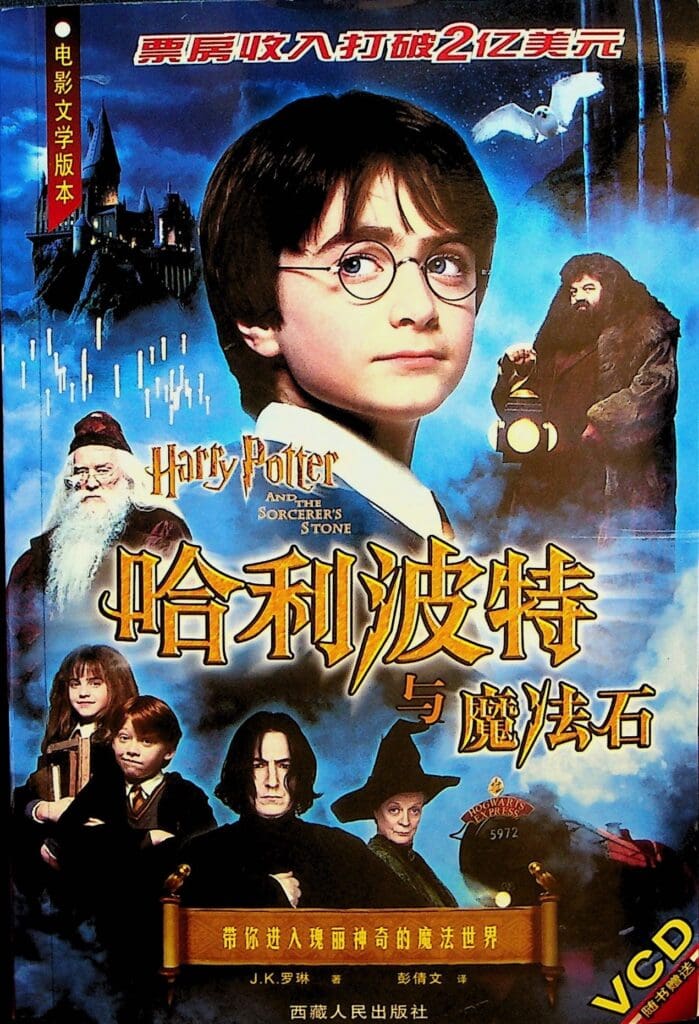
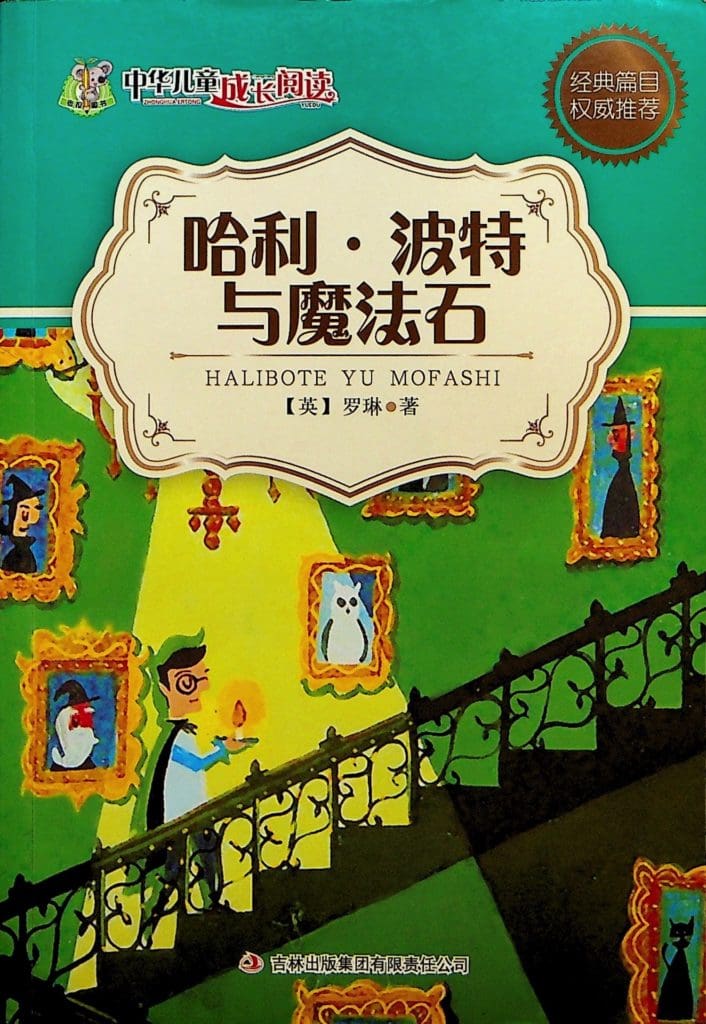
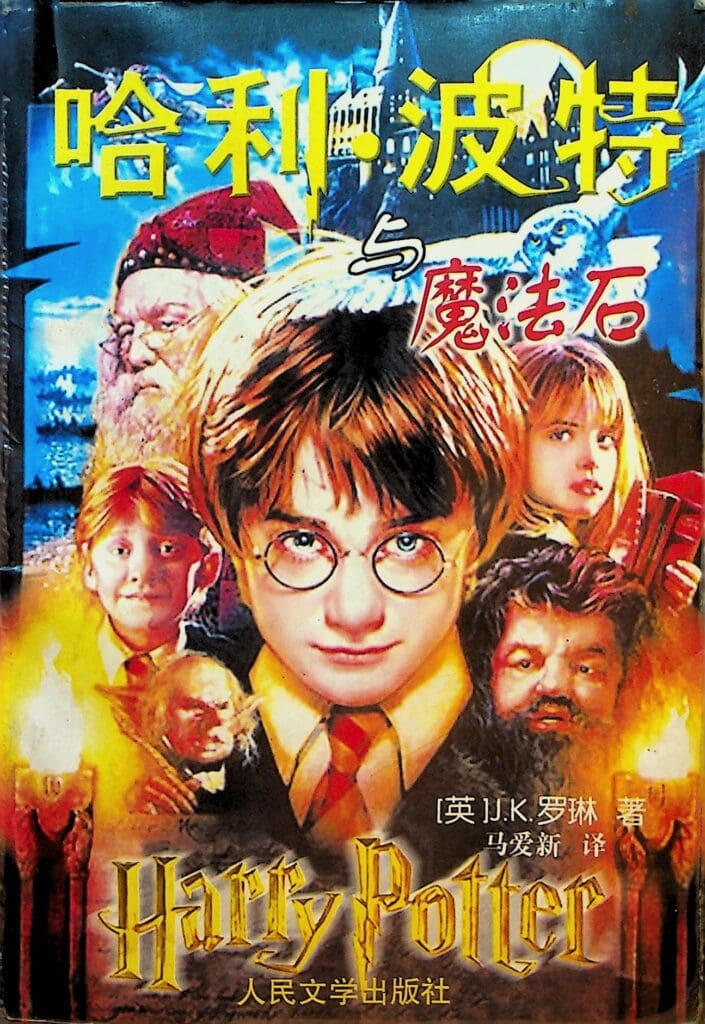
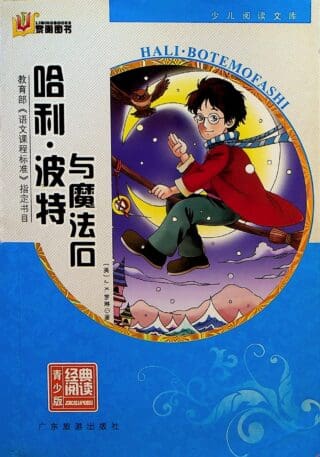
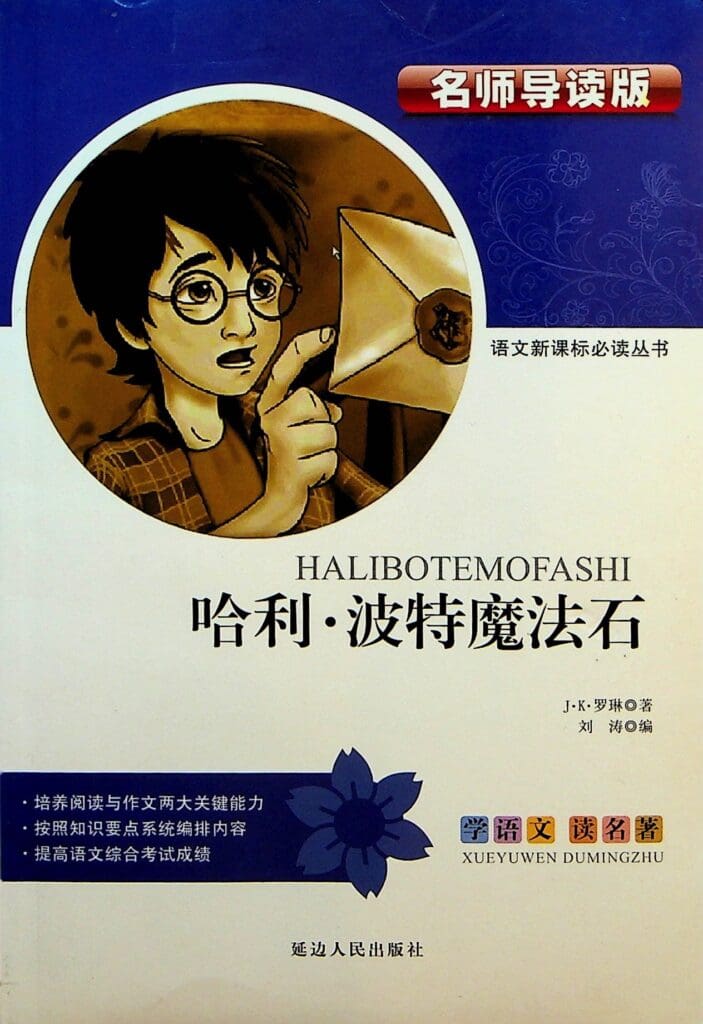
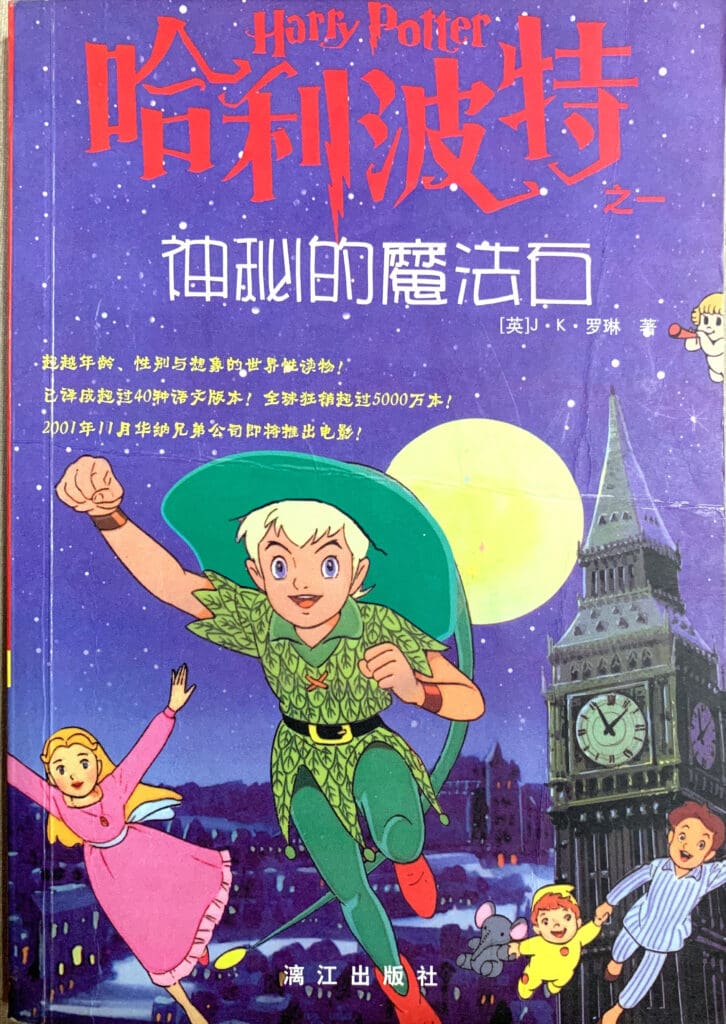
Before I go on, I really just have to address the “Peter Pan” cover art. I mean… it really is lifted directly from a Peter Pan book, although they wiped out Tinkerbell and hilariously they gave his hat a brim (cause that makes all the difference)! Added some background buildings that I guess are meant to be Hogwarts? Here’s the original in Greek (although I’ve seen translations with this cover in Basque, Chinese and Japanese as well).
You just have to laugh. It was published in 2000 so I suppose, being the relatively early days of the internet and especially the non-English internet, it was just harder to find something more appropriate.
Back to identifying these guys: if you can’t trust the ‘metadata’ on the cover and/or in the front matter, the only thing left to do is comparing the texts. Doing so comprehensively in a language that you don’t know—particularly using a complex writing system—is daunting to say the least. So as a starting point, I decided to compare chapter titles. These are the chapter titles for the two authorized translations by Su Nong (Simplified; PRC) and Peng Chien-wen (Traditional, Taiwan):
| English | Su Nong (Simplified) | Peng Chien-wen (Simplified, translit) | Peng Chien-wen (Traditional) |
|---|---|---|---|
| The Boy Who Lived | 大难不死的男孩 | 活下来的男孩 | 活下來的男孩 |
| The Vanishing Glass | 悄悄消失的玻璃 | 消失的玻璃 | 消失的玻璃 |
| The Letters from No One | 猫头魔传书 | 从天而降的信函 | 從天而降的信函 |
| The Keeper of the Keys | 钥匙保管员 | 钥匙管理员 | 鑰匙管理員 |
| Diagon Alley | 对角巷 | 斜角巷 | 斜角巷 |
| The Journey from Platform Nine and Three Quarters | 从93/4站台开始的旅程 | 自九又四分之三月台出发的旅程 | 自九又四分之三月台出發的旅程 |
| The Sorting Hat | 分院帽 | 分类帽 | 分類帽 |
| The Potions Master | 魔药课老师 | 魔药学老师 | 魔藥學老師 |
| The Midnight Duel | 午夜决斗 | 午夜的决斗 | 午夜的決鬥 |
| Hallowe’en | 万圣节前夜 | 万圣节惊魂 | 萬聖節驚魂 |
| Quidditch | 魁地奇比赛 | 魁地奇比赛 | 魁地奇比賽 |
| The Mirror of Erised | 厄里斯魔镜 | 意若思镜 | 意若思鏡 |
| Nicolas Flamel | 尼可 勒梅 | 寻找尼乐·勒梅 | 尋找尼樂·勒梅 |
| Norbert the Norwegian Ridgeback | 挪威脊背龙一诺伯 | 挪威脊背龙萝卜 | 挪威脊背龍蘿蔔 |
| The Forbidden Forest | 禁林 | 禁忌的森林 | 禁忌的森林 |
| Through the Trapdoor | 穿越活板门 | 穿越活板门 | 穿越活板門 |
| The Man with Two Faces | 双面人 | 双面人 | 雙面人 |
In the above table, I have included both Peng Chien-wen’s titles and a Simplified transliteration of those titles in order to better compare them to Su Nong’s. The blue characters in the the Peng Chien-wen columns are the characters that differ between Tradition and Simplified Chinese. In the Su Nong, column, the green-highlighted titles are identical to the Peng Chien-wen transliterated titles. As you can see, there is quite a lot of variation between the two translations—only three of the seventeen chapter titles are the same. That makes the chapter titles promising as a tool for an initial identification of the unauthorized translations.
Incidentally, the two authorized book titles are not the same either: Peng Chien-wen’s is 哈利波特—神秘的魔法石 (same in both Simplied and Traditional) and Su Nong’s is 哈利·波特与魔法石. They are very similar: Harry Potter (哈利波特) is the same, although Su Nong’s uses the convention of adding a dot between a person’s first and last name. Both use 魔法石, “magic stone”, but Peng Chien-wen added the extra word 神秘, “mystery” (的 serves the grammatical function of joining “mystery” to “magic stone”) and while Su Nong went with the more canonical 与, “and”, Peng Chien-wen just used an “m-dash”. So the difference is akin to: “Harry Potter: The Mystery of the Magic Stone” and “Harry Potter and the Magic Stone”.
Also, as an aside, the chapter title comparisons also provide a pretty good illustration of the difference between Simplified and Traditional Chinese characters; there is a lot of overlap between the two. That makes sense, of course—as a high level generalization in language, ‘frequent’ implies ‘simple’ both in speaking and in writing and so in the process of reducing the number and complexity of characters in Traditional Chinese to create Simplified Chinese, the most common, most frequent characters and forms are the ones statistically likely to be retained.
From here on out for brevity, I’m going to drop the English titles and because all of the books we’re examining are Simplified Chinese, I’m going to drop the Traditional Peng Chien-wen titles and just use the transliterated ones. I’m also going to use HANS for “Simplified Chinese” and HANT for “Traditional Chinese” as abbreviations—these are the ISO-15924 script identifier codes.
VCD
Let’s start with a relatively easy one—the VCD edition. The cover attributes the translation to Peng Chien-wen (like Dramatic Anime) and the publisher is listed as 西藏人民出版社, “Tibet People’s Publishing House”. For the title of the book; however, they do not use Peng Chien-wen’s title; they use the Su Nong title. It does appear to be a legit publishing house, but who knows whether they actually produced this book or not. The copyright page is consistent with the cover in that it lists the same publisher and translator—apparently it was published in 2002. The VCD note on the cover advertises the fact that this book, in fact, came with a bootleg VCD of a terrible camera recording of the Sorcerer’s Stone movie.
It’s worth noting too that, this is edition is quite colourful! Every internal page was pre-printed in either pink, blue, or green with a border of character images. Half the time it makes the text near illegible and it never changes so it’s quite repetitive, but, you know, it makes the book stand out!
Despite the translation being attributed to Peng Chien-wen, the chapter titles tell a different story.
| Su Nong | Peng Chien-wen (HANS) | VCD |
|---|---|---|
| 大难不死的男孩 | 活下来的男孩 | 大难不死的男孩 |
| 悄悄消失的玻璃 | 消失的玻璃 | 悄悄消失的玻璃 |
| 猫头魔传书 | 从天而降的信函 | 猫头魔传书 |
| 钥匙保管员 | 钥匙管理员 | 钥匙保管员 |
| 对角巷 | 斜角巷 | 对角巷 |
| 从93/4站台开始的旅程 | 自九又四分之三月台出发的旅程 | 从93/4站台开始的旅程 |
| 分院帽 | 分类帽 | 分院帽 |
| 魔药课老师 | 魔药学老师 | 魔药课老师 |
| 午夜决斗 | 午夜的决斗 | 午夜决斗 |
| 万圣节前夜 | 万圣节惊魂 | 万圣节前夜 |
| 魁地奇比赛 | 魁地奇比赛 | 魁地奇比赛 |
| 厄里斯魔镜 | 意若思镜 | 厄里斯魔镜 |
| 尼可 勒梅 | 寻找尼乐·勒梅 | 尼可 勒梅 |
| 挪威脊背龙一诺伯 | 挪威脊背龙萝卜 | 挪威脊背龙一诺伯 |
| 禁林 | 禁忌的森林 | 禁林 |
| 穿越活板门 | 穿越活板门 | 穿越活板门 |
| 双面人 | 双面人 | 双面人 |
All the VCD chapter titles are identical to the Su Nong chapter titles, and a casual comparison of various portions of the text confirm that it’s not Peng Chien-wen at all. It’s a straight-up bootleg of the authorized Su Nong translation.
Dramatic Anime
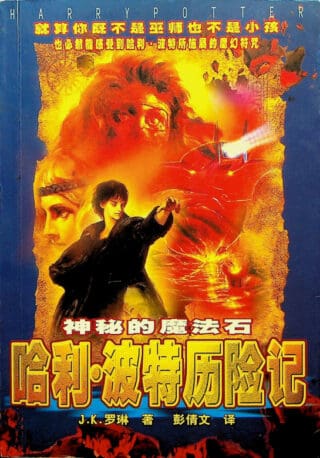
Next we’ll take a look at the Dramatic Anime edition because not only does it attribute itself to Peng Chien-wen, it also claims to have been published in 2000 by 西藏人民出版社, “Tibet People’s Publishing House”—the same as VCD; however, unlike VCD, it uses Peng Chien-wen’s title. I already revealed that it wasn’t a Peng Chien-wen transliteration like I hoped. Perhaps, like VCD, it’s just a Su Nong bootleg with a different cover? Spoiler alert: it’s not that either.
| Su Nong | Peng Chien-wen (HANS) | Dramatic Anime |
|---|---|---|
| 大难不死的男孩 | 活下来的男孩 | 幸存的男孩 |
| 悄悄消失的玻璃 | 消失的玻璃 | 消失的玻璃 |
| 猫头魔传书 | 从天而降的信函 | 从天而降的信函 |
| 钥匙保管员 | 钥匙管理员 | 钥匙管理员 |
| 对角巷 | 斜角巷 | 戴阿宫道 |
| 从93/4站台开始的旅程 | 自九又四分之三月台出发的旅程 | 自九又四分之三月台出发旅程 |
| 分院帽 | 分类帽 | 分类帽 |
| 魔药课老师 | 魔药学老师 | 魔药学老师 |
| 午夜决斗 | 午夜的决斗 | 午夜决斗 |
| 万圣节前夜 | 万圣节惊魂 | 万圣节惊魂 |
| 魁地奇比赛 | 魁地奇比赛 | 快迪斯比赛 |
| 厄里斯魔镜 | 意若思镜 | 魔法之镜 |
| 尼可 勒梅 | 寻找尼乐·勒梅 | 尼可拉斯·弗兰马尔 |
| 挪威脊背龙一诺伯 | 挪威脊背龙萝卜 | 挪威脊背龙诺贝特 |
| 禁林 | 禁忌的森林 | 禁忌的森林 |
| 穿越活板门 | 穿越活板门 | 冲破关卡 |
| 双面人 | 双面人 | 双面人 |
What to make of that? Nine out of seventeen titles match either Su Nong or Peng Chien-wen, but; i.e. about half. And while there are certainly other big overlaps, there are big differences even where Peng Chien-wen and Su Nong were quite similar. “Quidditch”, for example, 魁地奇比赛 vs. 快迪斯比赛 which amounts to just two different approaches to imitating the pronunciation of quidditch in Chinese.
It could be that someone made extensive revisions of one or the other’s text or maybe just the chapter titles. But why? If you’re going to bootleg a book—and even say it was done by the translator of an authorized translation!—why would you go to the the trouble? Comparing the texts, it’s pretty clear that it is distinct from both Su Nong and Peng Chien-wen’s translations. Dramatic Anime is a separate unauthorized translation by an unknown translator. In my opinion, of course. That said, I did also call on Z-Chen, a native speaker that helped me reclassify the “Staircase” edition and they agree that this is a completely different translation.
So, Dramatic Anime did not turn out to be the HANT>HANS transliteration I had hoped it was, but I’ll take a new translation any day!
Go to this edition in the TheList
Staircase
For completeness, I am including this one here even though I’ve written about it before. It’s a simplified and abridged variation of the Su Nong translation published in 2010 and again in 2015 by (allegedly) 吉林出版集团有限责任公司, the Jilin Publishing Group Co. Ltd.
Go to this macroedition in TheList
Movie Poster
What I found initially intriguing about this book is that the cover says the translator is 马爱新, “Aixin Ma” and the publisher is 人民文学出版社, “People’s Literature Publishing House” (the authorized PRC publisher). Aixin Ma translated/revised later books alone and with her sister, 马爱农 “Ainong Ma” who contributed is the “Nong” in “Su Nong”. So what the heck is this? Did Aixin Ma do her own translation, authorized or otherwise?
I’m not going to drag this out because it’s not worth it: this book is nothing interesting. Despite the cover, it’s not just PS, it’s a bootleg anthology of the authorized Su Nong PS, Aixin Ma COS and Aixin Ma POA. But the book is just garbage. It’s barely printed straight, the ink smudges, the paper quality is bottom of the barrel and the cover is barely thicker than the paper the rest of book is printed on. But worse, it’s missing half of POA—like just printed without it—and half way through COS, the page numbering jumps by about 30 pages. Not missing pages, just a big gap in the numbering. It’s the worst of the worst as bootlegs go.
Anime Broom
This “Anime Broom” edition is intriguing because although it uses the Su Nong title, it credits a new translator! One 李娟, “Li Huan”, and reportedly ‘adapted’ by 易海芬, “Yi Haifen”. A potential now translation is always exciting, but I did learn my lesson with Li Ronghua and the Staircase edition—take nothing for granted. Interestingly, like the Staircase edition, this one was also apparently abridged for children. Published by 广东旅游出版社, “Guangdong Tourism Press” (allegedly) in 2009, this is volume two in the “Children’s Reading Library”. And to be fair, it feels like a genuine attempt to be educational: for instance, it includes discussion questions at the end. Overall, it’s a relatively nice quality book. Is it a new translation though? Let’s go back to chapter titles—and at the risk of spoiling my own ending, for the sake of clarity, I’ll just show you the relevant comparison.
| Dramatic Anime | Anime Broom |
|---|---|
| 幸存的男孩 | 幸存的男孩 |
| 消失的玻璃 | 消失的玻璃 |
| 从天而降的信函 | 从天而降的信函 |
| 钥匙管理员 | 钥匙管理员 |
| 戴阿宫道 | 戴阿宫道 |
| 自九又四分之三月台出发旅程 | 自93/4月台开始的旅程 |
| 分类帽 | 分类物 |
| 魔药学老师 | 魔药学老师 |
| 午夜决斗 | 午夜决斗 |
| 万圣节惊魂 | 万圣节惊魂 |
| 快迪斯比赛 | 快迪斯比赛 |
| 魔法之镜 | 魔法之镜 |
| 尼可拉斯·弗兰马尔 | 尼可拉斯·弗兰马尔 |
| 挪威脊背龙诺贝特 | 挪威脊背龙诺贝特 |
| 禁忌的森林 | 禁忌的森林 |
| 冲破关卡 | 冲破关卡 |
| 双面人 | 双面人 |
The Chapter titles are virtually identical to Dramatic Anime—the only differences being: 1) whether “Platform 9 3/4” is written using Arabic or Chinese numerals and 2) a typo in the “Sorting Hat”—in the text itself, “Sorting Hat” appears as 分类帽, using the same last character (not coincidentally, meaning “hat”) that every edition, authorized and not, uses. The character used in the Anime Broom chapter title is pretty obviously a typo.
Carefully comparing sections of the text—although true to their claim it has been edited—it’s apparent that the source text was Dramatic Anime. Does that mean that later on, the unnamed translator became more willing to risk being caught for copyright violations? Probably not—Z-Chen thinks that more than likely it is another pseudonym and I’m inclined to agree. However, it does at least provide us with a name to attach to this unauthorized translation.
Harry Letter
“Harry Letter” is another kids abridged version. From outward appearances, it looks like an all around respectable, if illegal, publication. It was published in 2009 by 延边人民出版社, “Yanbian People’s Publishing House” (allegedly) and is ostensibly volume 1 of the “New Chinese Curriculum Standard Must-Read Series”. What’s odd is that it credits no one beside J.K. Rowling. What do the chapter titles tell us? Again, I’ll pull my punch a little for the sake of clarity.
| Su Nong | Harry Letter |
|---|---|
| 大难不死的男孩 | 幸存的男孩 |
| 悄悄消失的玻璃 | 悄悄消失的玻璃 |
| 猫头魔传书 | 猫头魔传书 |
| 钥匙保管员 | 钥匙保管员 |
| 对角巷 | 对角巷 |
| 从93/4站台开始的旅程 | 从943站台开始的旅程 |
| 分院帽 | |
| 魔药课老师 | 魔药课老师 |
| 午夜决斗 | |
| 万圣节前夜 | |
| 魁地奇比赛 | 魁地奇比赛 |
| 厄里斯魔镜 | |
| 尼可 勒梅 | 尼可 勒梅 |
| 挪威脊背龙一诺伯 | |
| 禁林 | 禁林 |
| 穿越活板门 | |
| 双面人 |
Well that’s unusual. In fact, this might be the most baffling of all of them all—you are seeing that correctly. The book only has ten chapters instead of the seventeen that PS has. Nine of them are identical to the Su Nong titles if you correct the typo in “Platform 9 3/4”. The last one, chapter 1, is completely different but it is one we’ve seen before: it’s Dramatic Anime’s chapter 1 title!
Going to the text: sure enough, this book is just what it appears to be. Chapter 1 is lifted verbatim from Dramatic Anime and the remaining chapters are lifted directly from Su Nong. The “abridgedness” of this book is that they just dropped seven chapters wholesale without regard for the story at all. They completely left out the ending!
The intention is clearly monetary and when you think of it that way, yeah, they want something that looks good on the outside—that will pass a cursory inspection—but they don’t actually care about the content at all. For me, that concept is so alien though—I’m sure I’m not the only one. And I really wonder why you’d go to the trouble of pulling one chapter from a different book? Surely that’s more work than just pulling from one source? I would love to know how that came about!
Peter Pan
And finally we come to this beautiful, wonderful abomination! I almost dismissed this one as a fake translation—I’m so glad I gave it a second look! It took me a good number of months to finally get a copy in hand and it was worth the wait. The book itself is a reasonably good quality publication; the cover as we’ve acknowledged is … something special—that’s not what it great. Although the book is clearly HANS and published in PRC, the title, 哈利波特—神秘的魔法石, is the HANT title and it credits Peng Chien-wen as the translator. What else is new, right? Apparently it was published in 2000 by 漓江出版社, “Lijiang Publishing House”. A cursory search suggests its a legitimate publisher but there’s no way of telling whether they actually published it… it does happen to have a well-formed ISBN that is registered to Lijiang Publishing House—but searching for it pulls up other books so it’s been reused. Whether by the publisher (not unheard of) or by a detail-oriented pirate, it’s impossible to tell.
Published in 2000… that stands out. Both authorized translations and the Dramatic Anime translation were published in 2000; everything else besides this Peter Pan edition came later. That warrants further scrutiny:
| Publication | Date |
|---|---|
| Peng Chien-wen, HANT (Original Authorized) | 2000-06 |
| Su Nong, HANS (Original Authorized) | 2000-09 |
| Peng Chien-wen (Li Huan), HANS (Dramatic Anime) | 2000-09 |
| Peng Chien-wen (?), HANS (Peter Pan) | 2000-09 |
Well that’s a striking pattern isn’t it? The Taiwanese publication comes out in June of 2000 and it appears there was a bit of a rush to capitalize on Harry Potter! Who knows when the authorized Su Nong translation was started—undoubtedly long before Peng Chien-wen’s translation was published. It must have been very popular in Taiwan though—I have a 12th print that was printed only five months after the first printing! I suspect that popularity motivated some individuals to push to meet (or beat) the publication of the People’s Literature Publishing House’s official translation.
Li Huan did their own translation and passed it off as Peng Chien-wen’s, probably to obscure it’s unscrupulous origins—so then what is the Peter Pan edition? Let’s take a look at the chapter titles.
| Peng Chien-wen (HANS) | Peter Pan |
|---|---|
| 活下来的男孩 | 活下来的男孩 |
| 消失的玻璃 | 消失的玻璃 |
| 从天而降的信函 | 从天而降的信函 |
| 钥匙管理员 | 钥匙管理员 |
| 斜角巷 | 斜角巷 |
| 自九又四分之三月台出发的旅程 | 自九又四分之三月台出发的旅程 |
| 分类帽 | 分类帽 |
| 魔药学老师 | 魔药学老师 |
| 午夜的决斗 | 午夜的决斗 |
| 万圣节惊魂 | 万圣节惊魂 |
| 魁地奇比赛 | 魁地奇比赛 |
| 意若思镜 | 意若思镜 |
| 寻找尼乐·勒梅 | 寻找尼乐·勒梅 |
| 挪威脊背龙萝卜 | 挪威脊背龙萝卜 |
| 禁忌的森林 | 禁忌的森林 |
| 穿越活板门 | 穿越活板门 |
| 双面人 | 双面人 |
The Peter Pan edition is a 100% match for the Peng Chien-wen HANT > HANS transliterated chapter titles. An examination of the text confirms the fact that Peter Pan is, in fact, the transliteration that I hoped the Dramatic Anime was! It’s a great strategy—transliterating the book doesn’t even need to be done by a human. So it’s not a surprise that this is a strategy someone wanting to cash-in quickly would jump on.
In hindsight, it’s obvious that there is also a correlation between the publication dates and the unusual artwork. Dramatic Anime and Peter Pan are the only ones that are completely inscrutable: they were published a full year before the first movie and long before there was an established Wizarding World aesthetic. Likely the only visuals they had easy access to were the Mary Grandpré—maybe the Thomas Taylor / Cliff Wright—covers which they were, I’m sure, eager to contrast with.
Why Peter Pan is a Big Deal
OK, so Peter Pan is a HANT > HANS transliteration. Why is that exciting (at least to me)?
Reason 1: Transliterations are few and far between—any transliteration is cool. This is only the second that we’ve seen that is not a Braille transliteration.
Reason 2: This is the first example we have of a transliteration as a form of regional adaptation. Braille, the most common transliterations we have observed, is a modality shift to accommodate a specific demographic that is visually impaired. Serbian Cyrillic and Latin are effectively for the same language population that is for all intents and purposes equally literate with both writing systems. Peter Pan is kind of like the Spanish adaptations in that it is tailored for a different population that speaks the same language—in this case the language use is not being adapted to the dialect, the writing system is being adapted to tailor the publication to the it’s target demographic.
Reason 3: Peter Pan is the first concrete evidence that supports a claim that I have made in the past and maintain is true: the choice to adapt or retranslate is generally a socio-economic, not a linguistic one. We have seen adaptations (the Spanish regions, Montenegrin, Valencian, English American) and we have seen multiple translations for different reasons (Chinese Traditional and Simplified, Serbian, Croatian, Bosnian, European and Brazilian Portuguese) and I have always maintained that the multiple translations could have been adaptations and vice-versa; that the reason they exist as they are, were business choices taking into account the political identity of the populations involved and the economics of international publishing. Peter Pan proves that my claim is plausible—it’s the first time we’ve seen both an adaptation (in this case a transliteration) coexisting with a second translation.
Isn’t that something to get excited about?!
